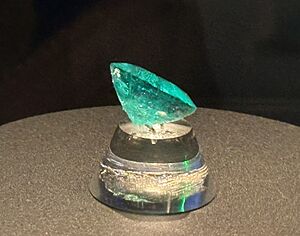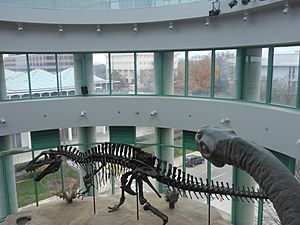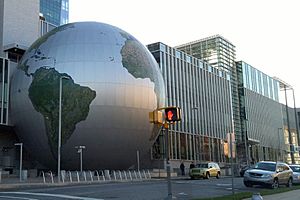North Carolina Museum of Natural Sciences facts for kids
 |
|

View of the Nature Exploration Center from E Jones Street
|
|
| Lua error in Module:Location_map at line 420: attempt to index field 'wikibase' (a nil value). | |
| Established | 1879 |
|---|---|
| Location | Raleigh, North Carolina |
| Type | Natural history museum |
| Visitors | 1.2 million (annually) |
The North Carolina Museum of Natural Sciences (NCMNS) is a cool natural history museum located in Raleigh, North Carolina. It's the oldest museum in the state. It's also the biggest natural history museum in the Southeastern United States.
This museum has six different buildings across five locations. The newest one, the North Carolina Museum of Natural Sciences at Greenville, opened on September 18, 2021. The NCMNS is part of North Carolina's state government.
Contents
Discovering the Museum's Past
The North Carolina State Museum started in 1879. It combined two collections of rocks and farm items. The museum was first in the Briggs Building on Fayetteville Street. Over 60 years, the museum grew a lot. This was thanks to Herbert Brimley, who took great care of it.
In 1887, the museum moved to the Department of Agriculture's office. This building was a former hotel on Edenton Street. As more items were collected, an extra part was added in 1899. In 1924, the museum moved into its own special building. It was later called the North Carolina State Museum of Natural History.
In the 1950s and 1990s, universities gave their collections to the state. This made the museum's collection even bigger. In 1986, its name changed to The North Carolina State Museum of Natural Sciences.
In 2000, the Museum of Forestry opened in Whiteville. This became the NC Museum of Natural Sciences in Whiteville in 2015. Another location, the Prairie Ridge Ecostation, opened in 2004. In 2012, the museum added the Nature Research Center in downtown Raleigh. The museum now has over 1.7 million items. These include amphibians, reptiles, birds, fish, mammals, invertebrates, fossils, plants, rocks, and meteorites.
In 2014, a dinosaur model and other items were taken from the museum. The people who took them turned themselves in a few days later. All the items were returned safely.
In 2020, the museum got the amazing Dueling Dinosaurs. This is a very well-preserved fossil from Montana. It shows a Triceratops and a Tyrannosaurus that might have been fighting. This fossil was found in 2006. It took many years to buy it because of legal issues. Friends of the North Carolina Museum of Natural Sciences helped raise money for it. The Dueling Dinosaurs exhibit opened in 2024. You can see it in the new SECU DinoLab.
Exploring the Nature Exploration Center
This part of the museum is on Jones Street in downtown Raleigh.
First Floor Adventures
- Natural Treasures of North Carolina – See cool displays of North Carolina wildlife. You can also find items like megalodon jaws and a Carolina parakeet specimen.
- Coastal North Carolina – This area shows what coastal North Carolina looks like. It has aquariums with live fish from the state's coast and rivers.
- WRAL 3-D Theater – Watch awesome 3-D movies in this 250-seat theater.
- Box Office – This is where you buy tickets for the 3-D theater and special shows.
Second Floor Discoveries

- Coastal North Carolina Overlook – Look down at the "Coastal North Carolina" hall. You'll see many marine mammal skeletons. This includes "Trouble," a sperm whale that was once the museum's mascot. Other skeletons include a blue whale and a rare True's beaked whale. You can also see "Mayflower," a North Atlantic right whale skeleton from 1874.
- North Carolina: Mountains to the Sea – Learn about North Carolina's different habitats. These range from the western mountains to the central Piedmont and the Coastal Plain. See species that are in danger of disappearing.
- Underground North Carolina – Explore gems and minerals from North Carolina. This includes the "Carolina Emperor," a huge 64.8-carat emerald. You can also learn about soil and earthquakes.
- Nature's Explorers – Discover how the museum started. See old ways of collecting and keeping specimens. There's a model of an ocean sunfish from 1937. You can also see Miss Kagawa, a rare Japanese Friendship Doll.
- Discovery Room – This is a fun, hands-on area for families.
- Special Exhibition gallery – This space changes often. It hosts new exhibits twice a year.
Third Floor Wonders

- Prehistoric North Carolina – Travel back in time to see ancient life in North America. This includes petrified wood and dinosaur skeletons. You can see Prestosuchus, Albertosaurus, Edmontosaurus, and Pachycephalosaurus. There's also "Willo," a famous Thescelosaurus fossil. For later ancient life, see a giant ground sloth skeleton. It was found near Wilmington. Walk through a recreated ancient ocean.
- Terror of the South – See a huge Acrocanthosaurus skeleton. This one is called "Acro" or "Fran." It's the biggest and most complete Acrocanthosaurus ever found. There's also a life-size model of the giant Astrodon dinosaur.
- Tropical Connections – Use a large interactive globe to learn about Earth's climate regions. See how North and South America are connected. This area also has live tropical animals. These include emerald tree boas and poison dart frogs.
- Mountain Cove – Learn about the wildlife of North Carolina's Appalachian Mountains. This section has live animal displays.
- Snakes of North Carolina – See live snakes that live in North Carolina.
- Windows on the World – This theater hosts talks, demonstrations, and live animal visits.
- Curiosity Classrooms – Two spaces for learning and activities.
- Bridge Across Time – This bridge connects the Nature Exploration Center to the Nature Research Center. It shows how ancient life left clues over millions of years.
Fourth Floor Living Exhibits
- Arthropod Zoo – See live and static displays of insects, crustaceans, arachnids, and other arthropods from North Carolina.
- Living Conservatory – This is a dry tropical forest exhibit. It has live plants and animals from Central and South America. You'll see over 200 tropical butterflies and a two-toed sloth. There are also ornate wood turtles, Stuart's milk snakes, cichlids, and a Brazilian black tarantula. A special room shows developing chrysalides and newly emerged butterflies.
Exploring the Nature Research Center
The Nature Research Center (NRC) is a huge, four-story building. It's across the street from the Nature Exploration Center. A walkway connects the two buildings. When it first opened in 2012, it stayed open for 24 hours! About 70,000 people visited.
The NRC offers hands-on activities. You can also watch scientists working in the labs. The museum uses distance learning to teach students across the state.
First Floor Science
- SECU Daily Planet Theater – This is a three-story theater inside a giant globe. It shows science presentations and amazing nature scenes.
- Our Changing Ocean – See a huge aquarium that looks like a hardbottom habitat off North Carolina's coast.
- Investigating Right Whales – Touch the skeleton of "Stumpy," a North Atlantic right whale. His death in 2004 led to laws that help protect whales from ships.
- Protecting Fresh Water – Learn why clean waterways are important. See how cities can grow while keeping water clean.
Second Floor Research
- Researching Weather – Discover how scientists study the weather.
- Diversity of Life – Learn about biodiversity and why many species are in danger. This area also has live animals.
- Window on Animal Health – Watch veterinary staff working on real medical procedures. You can even talk to them and see close-ups on screens. They care for reptiles, amphibians, fish, birds, small mammals, and invertebrates.
- Our Changing Climate – Hear from experts and students about how climate change affects our world.
Third Floor Discoveries
- Unraveling DNA – Learn about DNA, the building blocks of life. See a giant model of a DNA strand.
- Postcards from Space – Check out a collection of meteorites from space.
- Ancient Fossils, New Discoveries – See different fossils from across Earth's history. This includes a young Tyrannosaurus skeleton. You'll also find fossils from the Triassic Period, mammoths and mastodons from the Ice Age, and very old Ediacaran fossils.
- Planet Micro – See large models of tiny microbes.
Hands-on Labs for Learning
The Nature Research Center has interactive labs for everyone.
- Investigate Lab (third floor) – This lab explores new ideas in biotechnology and microbiology. You can learn about protozoa and genetic engineering.
- Naturalist Center – See some of the museum's 20,000 educational items. These include fossils, bones, and preserved animals. Use interactive tables to learn more about them.
- Vis Lab (third floor) – Learn about modeling and simulation. Take classes in electronics and computer programming.
Research Labs: See Scientists at Work
The Nature Research Center has five research labs. They are part of the museum's Research and Collections department. These labs have clear glass walls. This means you can watch scientists doing their work!
- SECU DinoLab (first floor) – Opened in 2024, this lab lets you watch scientists working on the Dueling Dinosaurs fossil. There are also other displays about the Cretaceous period.
- Biodiversity and Earth Observation Research Laboratory (second floor) – Scientists here study plants and animals. They focus on how mammals move and live.
- Astronomy and Space Observation Research Laboratory (third floor) – Astronomers use telescopes worldwide. They study how our Solar System began by looking at gas clouds around forming stars.
- Genomics and Microbiology Research Laboratory (third floor) – Biologists in this lab study DNA. They look at how different primates are related through their DNA.
- Paleontology and Geology Research Laboratory (third floor) – This lab focuses on theropod dinosaurs. This group includes the famous Tyrannosaurus rex and all living birds.
Other Museum Locations
Prairie Ridge Ecostation: Outdoor Learning
Prairie Ridge Ecostation is a 45-acre outdoor classroom. It's about 6 miles from the main museum in Raleigh. It has Piedmont prairie, forests, ponds, and a stream. It also shows off sustainable building features. This area is designed to be friendly to wildlife.
Prairie Ridge helps people understand and appreciate nature. It's an outdoor learning space. It also shows how to use renewable and sustainable energy. A Nature PlaySpace opened here in 2013.
North Carolina Museum of Natural Sciences at Whiteville
This museum is in Whiteville, North Carolina. It used to be called the North Carolina Museum of Forestry. Its goal is to celebrate the history and culture of North Carolina's forests. It has exhibits, programs, and items that show how forests and people are connected.
You can explore an outdoor Tree Trail and a Fossil Dig Pit. The museum also offers special events and educational programs.
North Carolina Museum of Natural Sciences at Contentnea Creek
This museum is in Grifton, North Carolina. It used to be called the Grifton Nature & Science Center. It's another outdoor classroom location. You can find hiking and paddling trails along Contentnea Creek. There's also an observatory and an outdoor classroom.
North Carolina Museum of Natural Sciences at Greenville
This museum is in Greenville, North Carolina. It used to be called A Time For Science (ATFS). It joined with the NCMNS in a partnership. The center was updated with new exhibits and reopened in September 2021. This museum is similar to the Raleigh location. But it has more exhibits about topics important to northeastern North Carolina. These include pirates and pollinators. It also uses resources from East Carolina University.
Fun Annual Events
The NCMNS hosts many special events each year. Here are some of the most popular:
- BugFest – This free festival is all about insects! It happens every mid-September. More than 35,000 people visit each year. A smaller version, BugFest South, is held at the Whiteville location in May or June.
- Dia de la Ciencia y la Cultura – This is a celebration of science, culture, and community. It's fully bilingual (Spanish-English). It takes place across both main museum buildings.
- Astronomy Days – This two-day event explores the universe. You can see technology, telescopes, and hear talks from scientists. There are also hands-on activities. It usually happens in January or February.
Images for kids
-
An Albertosaurus skeleton in the "Prehistoric North Carolina" hall.















